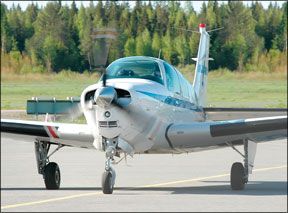Th
HISTORY
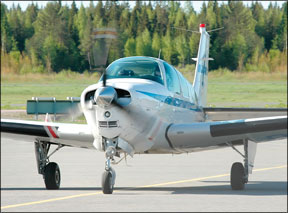
Ville Jalonen
Hawker Beechcraft is in the middle of its celebration of the 60th anniversary of production of the Bonanza. In one form or another, the Bonanza has been in continuous production since 1947, when the first V-tail was built-an astounding fact in itself. The 35 Bonanza was the first high-performance postwar single and was markedly different from the average light airplane of the day. Base price of the first models was $7975 ($79,477 in 2007 dollars). How times change.
Jump forward 21 years. In 1967, Beech had a hole in its model lineup. Archrival Cessna had been selling its six-place retractable single, the 210, since 1960 and by the end of the 1967 model year had rolled 936 through the factory doors. Cessna also had the 206 for the utility market.
Beech didnt have a truly comparable airplane. The V-tail S35 Bonanza, introduced in 1964, received a 19-inch cabin stretch that permitted the installation of a fifth and sixth seat. These were called “family” seats, and they really werent suitable for adults. The company kept working on a true six-place airplane.
For the 1968 model year, Beech introduced a stretched version of the Bonanza, with six seats, a conventional tail like that on the eight-year-old Debonair (redubbed 33 Bonanza that same year) and an aft set of doors. Base price of this first 36 Bonanza was $40,650, which rose to an average of $47,050 equipped ($247,470 in 2007 dollars). That same airplane is now worth an average of $115,000.
The original 36 was equipped with a six-cylinder Continental IO-520-B engine producing 285 HP and swinging a two-blade prop. It had some limitations compared to the later models: Club seating was not yet available and the standard fuel capacity was only 50 gallons, with 80 optional.
The stretch was accomplished by adding 10 inches to the fuselage of a 33 Bonanza; the 36 was not an all-new airplane. The length was added in such a way that the cabin moved forward, relative to the wing. Empty weight rose only 31 pounds.
The 36 was aimed at the utility and charter market dominated by Cessna, as a good choice for air taxi and cargo hauling. This was in contrast to the V-tail Bonanza, which was sold as an upscale business airplane. The 36 Bonanza could even be flown with the rear doors removed. Of course, the original 36 could be outfitted with options like a more plush interior.
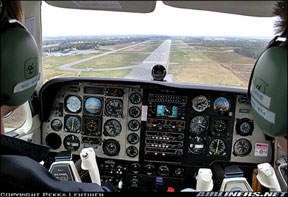
In 1970, the A36 debuted with the popular club seating option. The marketing focus changed, positioning the A36 more as a larger version of the other Bonanzas rather than as a utility airplane. Many of the “luxury” options became standard equipment.
In 1973, the fuel system was changed. Standard capacity actually went down to only 44 gallons, with a 74-gallon extended range system available. We believe its highly unlikely that there are any standard-capacity A36s in the fleet. An 80-gallon system was made standard in 1980.
As the years passed, the basic A36 remained largely unchanged, though in keeping with its real-world mission-a personal users IFR platform-more and more equipment was made standard. By 1976, an autopilot was standard, along with what is now a basic IFR suite. By 1986, the airplane was being delivered with RNAV, DME and plenty of other bells and whistles.
The biggest change to the airplane came in 1984, when a 300-HP Continental IO-550 replaced the IO-520. There was an all-new (and very we’ll laid out) instrument panel. Gone was the trademark Bonanza “throwover” control wheel with its massive central column in favor of a pair of ordinary control yokes. With the introduction of this airplane, the base price had roughly quadrupled over the original 36: $160,700 ($313,611 in 2007 dollars) with a current average value of $213,000.
The bigger engine can be retrofitted to older aircraft; a popular mod, judging by our reader feedback. TBO on all of the engines that have gone into the “straight” (non-
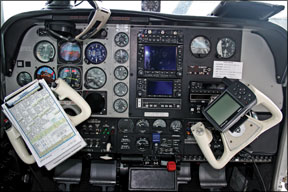
turbo) 36 Bonanzas is 1700 hours, with the estimated overhaul cost on the 520 currently at $25,000 or so and $28,000 for the 550.
Its not surprising that the IO-550 mod is popular. The IO-520 has had more than its share of woes, particularly case and head cracking, shortcomings that have not plagued the IO-550 to the same extent. An owner opting to switch rather than overhaul not only gets the extra power (for not a lot more fuel burn), but better service reliability as well.
The current G36 (G for Garmin 1000 glass panel) Bonanzas are the only Beech singles still in production; the last F33As were built in 1994. Current average equipped prices, according to the Aircraft Bluebook, range from $115,000 for an original 1968 model to $600,000 for new production.
Handling , PerformanceThis is why pilots love Bonanzas. The handling for its intended mission is just about as good as it gets, although the 36 is regarded as being a bit more ponderous than the sports-car-like V-tail 35. This is due mostly to the stretched fuselage, although that has its advantages over the 35 when it comes to weight and balance.
The somewhat higher control forces are also a safety feature in that they translate directly to rock-solid stability-desirable in an IFR platform. An airplane with
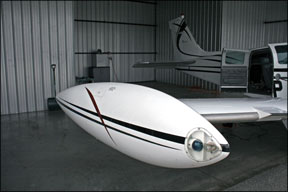
relatively high stick-force-per-G control forces is less likely to depart into a spiral if the pilot has to divert attention for a moment or two from the task of keeping the airplane upright and on course, something very important in slick, fast singles, as loss of control in IMC causes a significant number of accidents.
Landing is much easier than in some airplanes, although at extreme forward CG loadings (common when flying solo), it requires some determination to raise the nose in the flare and make a smooth landing. We did notice that fully 15 percent of the most recent 100 accidents involved landings-too much speed on touchdown (overrun) or loss of control on rollout.
One characteristic of the classic V-tail that is blessedly reduced in the 36 is the notorious tendency to Dutch roll in turbulence. The extra length makes for a more comfortable ride. In keeping with its mission as a serious cross-country machine, performance is respectable: Normal cruise is about 165 knots, with a 1000 FPM-plus initial climb rate.
InteriorThe 36 has excellent visibility and is quite comfortable, although headroom and legroom is cramped for taller pilots and passengers. With four aboard, its a luxury liner, but adding a fifth and sixth person makes things tight. There is a noticeable shortage of baggage space. There’s some room aft of the third row of seats (watch that CG envelope!) and the only place to stow things is the modest slot
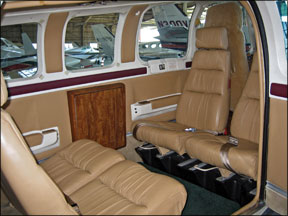
between the front seats and the rear-facing center row. There is not enough room to fit six people and six bags on board.
Up front, the panel is generally we’ll organized, although at the time the earlier 36 Bonanzas were made, Beech was still using the “backwards” or “airline” positioning of the gear and flap switches with gear on the right and flaps on the left. It wasnt “right” or “wrong,” but just different. But it has led to many inadvertent gear retractions. Later models have the switches placed as they are in other airplanes.
Crashworthiness, SafetyBeech paid attention to crashworthiness and survivability providing a strong “keel” arrangement from the aft end of the cabin to the nose. Its tied into a sturdy rollover structure which provides anchor points for shoulder harnesses for all occupants (four-point style for the front seats). There are openable side windows that function as emergency exits. There no separate door or exit for the pilot. The fuel tanks are in front of the main spar, which lessens their protection in a crash and means that the center of gravity moves aft as fuel is burned.
The gear is massive. Its the same landing gear used for the Baron, where it has to support far more weight. The military T-34 trainer is basically a Bonanza, and as a result the gear had to be subjected to severe drop tests to satisfy the Pentagon. All that structure underneath the cabin also helps to absorb impact forces in a crash.
Another nice thing about the gear is that its electromechanical and, if correctly maintained, has proven reliable. Of the last 100 accidents, only two involved the
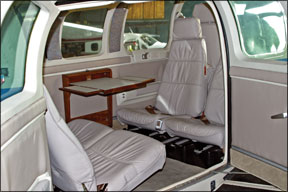
landing gear, although we recognize that the NTSB doesnt consider a gear-up landing to be an accident and thus not all events get reported.
Emergency extension is through a simple hand crank located behind the front seats. The 36 Bonanza also has a simple feature lacking in many aircraft: an easy-to-open “barn door” cowl, making preflight of the engine easy. This is really a safety feature, in our opinion.
The 36 Bonanzas have a much longer CG range that the model 35 series, although not as long as its competitor, the Cessna 210. Both fore and especially aft loading has to be carefully watched. A pilot flying solo with a full fuel load might have difficulty getting the CG aft of the forward limit. Trying to carry six passengers (reduced fuel is necessary) and any baggage aft of the rear seats may not be possible.
Factory SupportOne of the great things about owning a Bonanza is that the factory (now Hawker Beechcraft) is there, still producing new Bonanzas and doesnt seem to be in any sort of financial trouble. Owners report that getting parts is not a problem, although the cost of those parts is high. Bonanza ownership is not nor has it ever been for penny pinchers. Hawker Beechcraft also operates a number of service centers in the U.S., Mexico and the U.K.
Mods, ClubUnlike the V-tail, the 36 Bonanzas being built today are very similar to the first ones off the line: The biggest difference is the engine. As a result, there arent quite as many mods as for the smaller airplane, though the list is still a healthy one.
As noted above, upgrading the IO-520 to the IO-550 is a popular option when it comes time to overhaul. The STC is available from a wide variety of sources, including the factory. We have been particularly impressed with Tornado Alley Turbos (http://www.taturbo.com/) turbonormalization mod for the A36 that adds 400 pounds to the gross weight and makes the airplane capable of carrying 4 people 1000 miles at 200 knots.
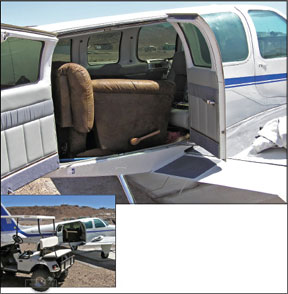
Owners of two-bladed props can upgrade to the three-bladed airscrew from Hartzell at (http://www.topprop.com/). Also available are various speed mods and even vortex generators. The best source of current information about mods is the American Bonanza Society. They offer service clinics, fly-ins and a good magazine. The ABS is located in Wichita, Kansas (where else?). Find them at 316-945-1700, or (http://www.bonanza.org/). In our opinion we would not own a Bonanza without being a member of the ABS.
Owner CommentsIve owned a 1993 A36 for six years and 1100 hours. It has been nearly perfect for my needs, combining speed and utility like nothing else. Most of my flying is with just one passenger; Ive filled all six seats just twice in six years. On the other hand, we often carry a lot of stuff. Weve carried furniture, loads of Christmas presents, four people and their ski gear, a tandem bicycle, even an automobile hardtop. The utility of those big rear doors and the ease of popping out the seats is unbeatable.
Stock, the later planes are short on useful load for a six-seater. All planes tend to gain empty weight over the model years but the 36 gained more than most. Along with the usual trend to plusher interiors, Beech economized by increasing parts commonality with the Baron, substituting beefier Baron parts in place of the original Bonanza parts. This isn’t all bad, as the heavier parts are stronger. The recent expensive spar AD only applies to A36s through a serial number around 1990, for example. But if youre planning to fill the plane with adults, look at the early planes.
Aftermarket tip tanks increase the gross weight to 3800 pounds which is one reason they are so popular on 36s.
The best thing Ive done to the airplane is adding the Tornado Alley Turbonormalizer system. It truly transforms the airplane. Ive had it into the low 20s a few times, but its most comfortable in the teens where you can use cannulas instead of messing with masks. The TAT system also comes with a gross weight boost all the way to 4000 pounds, boosting the useful load by almost 300 pounds. I also added the TKS de-icing system which, here in the Seattle area, gets used from about September to May.
The factory engine lasted over 2000 hours, 300 past TBO. It was still going strong when I pulled it to add the turbo. The first cylinders were replaced at 900 hours by a previous owner. Since that time, its been run lean of peak continuously.
Ive found that using a Beech-savvy mechanic does make a difference. Fortunately, those arent hard to find. The American Bonanza Society is a mandatory resource for an owner, albeit a bit dated as they mostly concentrate on older V-tails. The Beech Owners mailing list is more up-to-date, faster and a tremendous resource, if you can stand sorting through 100+ emails a day to find the gems.
The biggest problem with the 36 is that there’s no reasonable upgrade path beyond it in anything made in the last 20 years. Once youve been spoiled by those big doors, loading flexibility and pop-out seats, you cant imagine giving them up. To get more speed, plus pressurization, while matching the utility would mean a quantum leap to something like a Pilatus.
Dave Van Horn
Seattle, Washington.
My 1973 A36 and I have been together for 16 years and I couldnt have made a better pick of airplanes. The plane is a joy to fly, easy, smooth and dependable. In 1996, I had Van Carpenter in Pagosa Springs, install a factory reman Hartzell three-
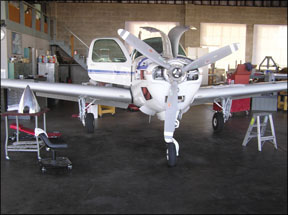
blade, complete intercooler and turbo normalizer. My initial test/acceptance flight with Tom Turner was a good 208 knots at 17,500 feet and 75 percent power. The engine now has almost 1400 hours and it uses only one quart between oil changes. I usually fly 12 to 15,000 feet here in Arizona and average 185 knots. Fuel burn is about 18 GPH running rich of peak and 14 GPH lean of peak.
Annuals run somewhere between $2800 and $3600. Generally, each year I will do an extra replacement or upgrade in addition to the annual. New tires one year, new fuel bladders another and so on. I cant fail to recommend the A36 to anyone who can use a fast, dependable, nice looking plane. Although short field performance is not as good as some other makes and models, I get in and out of a 2000-foot dirt strip in Mexico without any problems.
Bob Corbett
Yuma, Arizona
I co-own a 1988 Beechcraft A-36 Bonanza. We purchased it in March 2002 with a fresh factory remanufactured engine. It now has 2620 total time and 1070 SMFRM with 336 STOH. It has proven to be the best all-around piston, single-engine airplane I have owned. Its a delight to fly with the proper balance between responsiveness and stability to make it fun to maneuver yet a stable instrument platform. The club seating arrangement in the aft cabin is roomy and easily accessible through the clam-shell doors.
The emergency window exits on each side are reassuring; particularly the one on the left side in case the cockpit and cabin doors on the right side of the fuselage are rendered inoperable. The turbine-style engine gauges, standard gear and flap arrangement, tr aditional throttle quadrant, plus the 154-knot gear extension and approach flap speeds make post-1984 Bonanzas the ultimate in the lineage.
The Continental IO-550 is a dream engine. Follow the Aircraft Flight Manuals checklist for cold and hot engine starts, and it fires right up. The huge cowling doors on both sides allow for unsurpassed ease of access for inspection of the engine. The keel mount for the engine reduces vibration transmitted to the cabin. Engine cooling in Bonanzas seems to be an endemic problem. We faced high CHTs in cruise and near redline temps during climb. Tweaking the baffle installation did nothing to resolve the high CHTs. After detecting evidence of heat damage to several cylinders, we exchanged all the cylinders and installed the Beryl DShannon louvers along with an EI UBG16 engine monitor. The louvers reduced CHTs by over 20 degrees and are strongly recommended. They are the same style as installed on late model Bonanzas by the factory.
Owning a high-performance technologically advanced aircraft, such as our Bonanza with the Garmin GNS530W and GDL-69 receiver, is as much a matter of attitude as it is cash flow. The insurance industry feels the same by mandating annual flight reviews and Instrument Proficiency Checks in the aircraft as a condition of coverage. Underwriters look carefully at the pilots age, currency and on-going proficiency in the aircraft as they set the price for premiums and limits of coverage.
Maintenance for our aircraft has been pretty routine for this caliber of aircraft. The landing gear rigging merits careful attention by someone familiar with the system. A minor issue with major consequences is keeping the drain holes to the bathtub fittings for the wing bolts open to allow water to drain. Otherwise, the fittings will accumulate water and grit, setting the stage for corrosion.
Our vexation has been the air conditioner as it goes through belts and recharges of Freon on a regular basis. The cowling-mounted landing light is also a maintenance item as vibration destroys filaments. After going through a series of landing lights, we installed the LoPresti BoomBeam HID landing light. That resolved the ongoing light bulb replacement issue, plus it dramatically improved our ability to see our surroundings at night and be seen by other traffic. We were also going through light bulbs on the tail-mounted anti-collision light. Replacement with the amazing Whelen LED system corrected that matter.
The assembly is smaller than the original system, looks like a diamond on the tail and really increases visibility without harming night vision. The aft cabin gets a little too cold and drafty in the winter and hot in the summer. We look forward to checking the validity of advice received during an American Bonanza Society clinic to seal the aft bulkhead/fuselage junction to reduce the draftiness in the winter and close the firewall shut off valve to reduce the heat coming into the cabin in the summer.
We replaced our standard VSI with an Aspen AT300 Digital VSI/color TAWS. It is a slick unit providing bar graph and numeric vertical speed and height above terrain depictions, as we’ll as a view of the surrounding topography. The majority of later-model Bonanzas have a standby vacuum system, which has been used twice since owning the plane.
We also installed the B&C standby alternator for additional peace of mind. The K&N engine air filter from Knots2U made good on the claim of a slight increase in power as shown by an incremental increase in airspeed and fuel flows for a given power setting. The Rosen sun visors are a useful replacement for the standard sun visors.
The airplane came with Beryl DShannon tip tanks. They are a fantastic addition that expands the envelope of range versus useful load. With 30 additional gallons of fuel capacity and the added gross weight, the plane becomes a serious cross-country traveler or load hauler. The STC allows for an increase of 183 pounds to 3833 maximum gross weight at takeoff from the 3650 pounds maximum takeoff weight without the Beryl DShannon tip tanks.
An allowance of 13 additional pounds of ramp weight is granted for fuel burned during engine start and taxi. With an empty weight of 2553 pounds, our airplane has a useful load of 1280 pounds to balance between fuel and payload. The operation of the tip tanks is through on-off switches on the instrument panel that activate pumps located in the main landing gear wheel wells to transfer fuel from the tip tanks to the wing tanks.
One must be sure to have burned some fuel from the main tanks to make room for the fuel being transferred from the tip tanks; otherwise, the fuel will be dumped overboard. Translucent “windows” in their fiberglass structure allow for direct viewing of the fuel contained in the tip tanks. The tip tanks also have a “keel effect” providing added in-flight stability, which greatly reduces the fishtailing tendency in turbulence characteristic of Bonanzas. The penalty exacted by the additional lift generated by the tip tanks is a reduction in the design maneuvering speed from 141 KIAS to 134 KIAS.
Membership in the American Bonanza Society (http://www.bonanza.org/) is a must-do item for any Bonanza owner or pilot. Their pre-purchase checklist is a terrific resource. Their service clinics are we’ll worth the price of admission as experts evaluate the plane and identify maintenance matters overlooked by the typical mechanic. The ABS is also taking a leadership role in its investigation of the issues surrounding the AD addressing cracks in the carry-through spar webs. The result of this work may influence how the FAA deals with this AD affecting Beechcraft products, and on a grander scale, issues surrounding aging aircraft.
The Beechcraft reputation for quality is readily apparent in our airplane. The product support has been good. It is a great looking aircraft on the ramp that gives us a tremendous sense of pride in co-ownership. With TAS in the 165 to 170 knot range, we can make most trips to destinations up to 650 miles in less block time than the airlines. It may be pushing 60 years old, but Beech definitely got this design right.
Alan Beason
Shreveport, Louisiana

